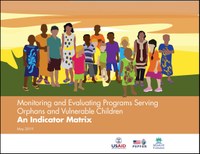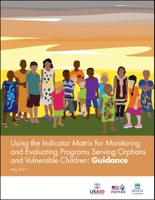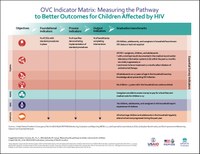Indicator Matrix and Guidance for Monitoring and Evaluating Programs Serving Orphans and Vulnerable Children

The United States President’s Emergency Plan for AIDS Relief (PEPFAR) engaged the United States Agency for International Development (USAID)- and PEPFAR-funded MEASURE Evaluation project to develop and support the rollout of an overarching matrix that outlines the pathway to better outcomes for children affected by HIV. PEPFAR assembled a team of experts from its partner agencies and MEASURE Evaluation to design an indicator matrix that maps the current required PEPFAR orphans and vulnerable children (OVC) indicators and complements them with additional recommended foundational, process, output, and outcome indicators and the newly established PEPFAR global OVC graduation benchmarks (https://www.measureevaluation.org/resources/publications/tl-18-20).
The team’s work resulted in these two resources:
- Monitoring and Evaluating Programs Serving Orphans and Vulnerable Children: An Indicator Matrix
- Using the Indicator Matrix for Monitoring and Evaluating Programs Serving Orphans and Vulnerable Children: Guidance
The OVC indicator matrix has the following uses:
- Guide OVC program stakeholders to measure what matters and to consider repurposing or selecting new or custom indicators that better inform project performance
- Provide sample indicators that can be used to measure how OVC projects are contributing to the global 95-95-95 targets and prevention and mitigation goals
- Demonstrate relationships among PEPFAR’s reporting requirements
The matrix consists of 12 tables, each of which focuses on a key project objective and contains a set of foundational, process, output, and outcome indicators that can be used to measure progress in achieving the respective objective.
The companion guidance manual introduces the matrix—explaining its purpose and how it can be used. It describes the process that may be followed for selecting indicators from the matrix and adapting and operationalizing them. It includes several helpful tools: for example, a sample agenda for a workshop to prioritize the indicators and a table that aligns the eligible essential OVC services with the matrix.















